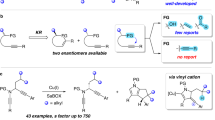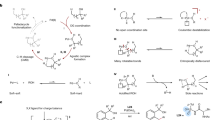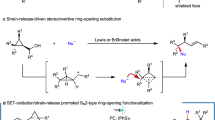Abstract
The functionalization of carbon–hydrogen (C–H) bonds is one of the most attractive strategies for molecular construction in organic chemistry. The hydrogen atom is considered to be an ideal coupling handle, owing to its relative abundance in organic molecules and its availability for functionalization at almost any stage in a synthetic sequence1. Although many C–H functionalization reactions involve C(sp3)–C(sp2) coupling, there is a growing demand for C–H alkylation reactions, wherein sp3 C–H bonds are replaced with sp3 C–alkyl groups. Here we describe a polarity-match-based selective sp3 C–H alkylation via the combination of photoredox, nickel and hydrogen-atom transfer catalysis. This methodology simultaneously uses three catalytic cycles to achieve hydridic C–H bond abstraction (enabled by polarity matching), alkyl halide oxidative addition, and reductive elimination to enable alkyl–alkyl fragment coupling. The sp3 C–H alkylation is highly selective for the α-C–H of amines, ethers and sulphides, which are commonly found in pharmaceutically relevant architectures. This cross-coupling protocol should enable broad synthetic applications in de novo synthesis and late-stage functionalization chemistry.
This is a preview of subscription content, access via your institution
Access options
Access Nature and 54 other Nature Portfolio journals
Get Nature+, our best-value online-access subscription
$29.99 / 30 days
cancel any time
Subscribe to this journal
Receive 51 print issues and online access
$199.00 per year
only $3.90 per issue
Buy this article
- Purchase on Springer Link
- Instant access to full article PDF
Prices may be subject to local taxes which are calculated during checkout




Similar content being viewed by others
References
Davies, H. M. L. & Morton, D. Recent advances in C–H functionalization. J. Org. Chem. 81, 343–350 (2016)
Chen, X., Engle, K. M., Wang, D.-H. & Yu, J.-Q. Palladium(II)-catalyzed C–H activation/C–C cross-coupling reactions: versatility and practicality. Angew. Chem. Int. Ed. 48, 5094–5115 (2009)
Ackermann, L. Metal-catalyzed direct alkylations of (hetero)arenes via C–H bond cleavages with unactivated alkyl halides. Chem. Commun. 46, 4866–4877 (2010)
Lyons, T. W. & Sanford, M. S. Palladium-catalyzed ligand-directed C−H functionalization reactions. Chem. Rev. 110, 1147–1169 (2010)
Colby, D. A., Tsai, A. S., Bergman, R. G. & Ellman, J. A. Rhodium catalyzed chelation-assisted C–H bond functionalization reactions. Acc. Chem. Res. 45, 814–825 (2012)
Schönherr, H. & Cernak, T. Profound methyl effects in drug discovery and a call for new C–H methylation reactions. Angew. Chem. Int. Ed. 52, 12256–12267 (2013)
Zhang, Y.-H., Shi, B.-F. & Yu, J.-Q. Palladium(II)-catalyzed ortho alkylation of benzoic acids with alkyl halides. Angew. Chem. Int. Ed. 48, 6097–6100 (2009)
Aihara, Y. & Chatani, N. Nickel-catalyzed direct alkylation of C–H bonds in benzamides and acrylamides with functionalized alkyl halides via bidentate-chelation assistance. J. Am. Chem. Soc. 135, 5308–5311 (2013)
Ackermann, L., Novák, P., Vicente, R. & Hofmann, N. Ruthenium-catalyzed regioselective direct alkylation of arenes with unactivated alkyl halides through C–H bond cleavage. Angew. Chem. Int. Ed. 48, 6045–6048 (2009)
Ilies, L., Matsubara, T., Ichikawa, S., Asako, S. & Nakamura, E. Iron-catalyzed directed alkylation of aromatic and olefinic carboxamides with primary and secondary alkyl tosylates, mesylates, and halides. J. Am. Chem. Soc. 136, 13126–13129 (2014)
Shabashov, D. & Daugulis, O. Auxiliary-assisted palladium-catalyzed arylation and alkylation of sp2 and sp3 carbon−hydrogen bonds. J. Am. Chem. Soc. 132, 3965–3972 (2010)
Zhang, S.-Y., Li, Q., He, G., Nack, W. A. & Chen, G. Stereoselective synthesis of β-alkylated α-amino acids via palladium-catalyzed alkylation of unactivated methylene C(sp3)–H bonds with primary alkyl halides. J. Am. Chem. Soc. 135, 12135–12141 (2013)
Zhu, R.-Y., He, J., Wang, X.-C. & Yu, J.-Q. Ligand-promoted alkylation of C(sp3)–H and C(sp2)–H bonds. J. Am. Chem. Soc. 136, 13194–13197 (2014)
Adams, J. et al. Rhodium acetate catalyzes the addition of carbenoids α- to ether oxygens. Tetrahedr. Lett. 30, 1749–1752 (1989)
Davies, H. M. L., Venkataramani, C., Hansen, T. & Hopper, D. W. New strategic reactions for organic synthesis: catalytic asymmetric C−H activation α to nitrogen as a surrogate for the Mannich reaction. J. Am. Chem. Soc. 125, 6462–6468 (2003)
Doyle, M. P., Duffy, R., Ratnikov, M. & Zhou, L. Catalytic carbene insertion into C−H bonds. Chem. Rev. 110, 704–724 (2010)
Prier, C. K., Rankic, D. A. & MacMillan, D. W. C. Visible light photoredox catalysis with transition metal complexes: applications in organic synthesis. Chem. Rev. 113, 5322–5363 (2013)
Shaw, M. H., Twilton, J. & MacMillan, D. W. C. Photoredox catalysis in organic chemistry. J. Org. Chem. 81, 6898–6926 (2016)
Kärkäs, M. D., Porco, J. A. & Stephenson, C. R. J. Photochemical approaches to complex chemotypes: applications in natural product synthesis. Chem. Rev. 116, 9683–9747 (2016)
DiRocco, D. A. et al. Late-stage functionalization of biologically active heterocycles through photoredox catalysis. Angew. Chem. Int. Ed. 53, 4802–4806 (2014)
Zuo, Z. et al. Merging photoredox with nickel catalysis: coupling of α-carboxyl sp3-carbons with aryl halides. Science 345, 437–440 (2014)
Zhang, X. & MacMillan, D. W. C. Alcohols as latent coupling fragments for metallaphotoredox catalysis: sp3–sp2 cross-coupling of oxalates with aryl halides. J. Am. Chem. Soc. 138, 13862–13865 (2016)
Roberts, B. P. Polarity-reversal catalysis of hydrogen-atom abstraction reactions: concepts and applications in organic chemistry. Chem. Soc. Rev. 28, 25–35 (1999)
Jeffrey, J. L., Terrett, J. A. & MacMillan, D. W. C. O–H hydrogen bonding promotes H-atom transfer from α C–H bonds for C-alkylation of alcohols. Science 349, 1532–1536 (2015)
Shaw, M. H., Shurtleff, V. W., Terrett, J. A., Cuthbertson, J. D. & MacMillan, D. W. C. Native functionality in triple catalytic cross-coupling: sp3 C–H bonds as latent nucleophiles. Science 352, 1304–1308 (2016)
Lowry, M. S. et al. Single-layer electroluminescent devices and photoinduced hydrogen production from an ionic iridium(III) complex. Chem. Mater. 17, 5712–5719 (2005)
Durandetti, M., Devaud, M. & Périchon, J. Investigation of the reductive coupling of aryl halides and/or ethyl chloroacetate electrocatalyzed by the precursor NiX (bpy) with X = Cl, Br, or MeSO4 and bpy = 2,2′-dipyridyl. New J. Chem. 20, 659–667 (1996)
Gutierrez, O., Tellis, J. C., Primer, D. N., Molander, G. A. & Kozlowski, M. C. Nickel-catalyzed cross-coupling of photoredox-generated radicals: uncovering a general manifold for stereoconvergence in nickel-catalyzed cross-couplings. J. Am. Chem. Soc. 137, 4896–4899 (2015)
Cheung, M. S., Sheong, F. K., Marder, T. B. & Lin, Z. Computational insight into nickel-catalyzed carbon–carbon versus carbon–boron coupling reactions of primary, secondary, and tertiary alkyl bromides. Chem. Eur. J. 21, 7480–7488 (2015)
Cernak, T., Dykstra, K. D., Tyagarajan, S., Vachal, P. & Krska, S. W. The medicinal chemist’s toolbox for late stage functionalization of drug-like molecules. Chem. Soc. Rev. 45, 546–576 (2016)
Acknowledgements
This research was supported by the NIH National Institute of General Medical Sciences (R01 GM078201-05) and gifts from Merck, Bristol-Myers Squibb, Eli Lilly and Johnson & Johnson. The authors thank T. Liu for assistance in preparing this manuscript.
Author information
Authors and Affiliations
Contributions
C.L., Y.L., R.W.E. and X.L. performed and analysed the experiments. C.L., Y.L., R.W.E., X. L. and D.W.C.M. designed the experiments. C.L., Y.L., R.W.E., X.L. and D.W.C.M. prepared the manuscript.
Corresponding author
Ethics declarations
Competing interests
The authors declare no competing financial interests.
Additional information
Reviewer Information Nature thanks M. Greaney and the other anonymous reviewer(s) for their contribution to the peer review of this work.
Publisher's note: Springer Nature remains neutral with regard to jurisdictional claims in published maps and institutional affiliations.
Supplementary information
Supplementary Information
This file contains supplementary information regarding HAT-Alkylation – see contents page for full details. (PDF 34045 kb)
Rights and permissions
About this article
Cite this article
Le, C., Liang, Y., Evans, R. et al. Selective sp3 C–H alkylation via polarity-match-based cross-coupling. Nature 547, 79–83 (2017). https://doi.org/10.1038/nature22813
Received:
Accepted:
Published:
Issue Date:
DOI: https://doi.org/10.1038/nature22813
This article is cited by
-
Photoredox-catalyzed diastereoselective dearomative prenylation and reverse-prenylation of electron-deficient indole derivatives
Nature Communications (2023)
-
Site- and enantioselective cross-coupling of saturated N-heterocycles with carboxylic acids by cooperative Ni/photoredox catalysis
Nature Communications (2023)
-
Photochemical diversification of strong C(sp3)–H bonds enabled by allyl bromide and sodium fluoride
Nature Synthesis (2023)
-
Recyclable Copper-Catalyzed Decarboxylative C–C Coupling of the sp3-Hybridized Carbon Atoms of α-Amino Acids
Catalysis Letters (2023)
-
Silver-catalyzed site-selective C(sp3)−H benzylation of ethers with N-triftosylhydrazones
Nature Communications (2022)
Comments
By submitting a comment you agree to abide by our Terms and Community Guidelines. If you find something abusive or that does not comply with our terms or guidelines please flag it as inappropriate.



